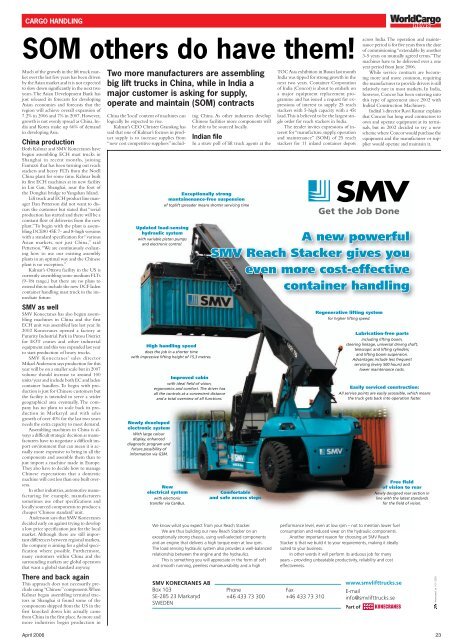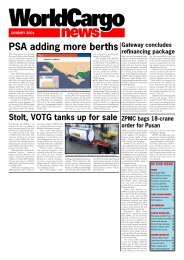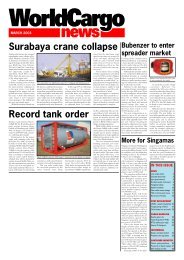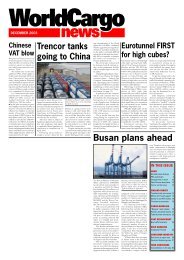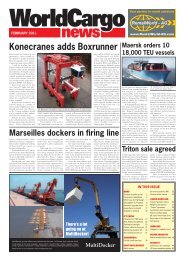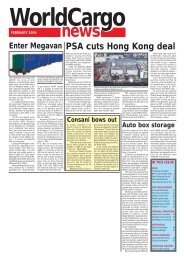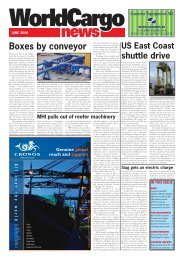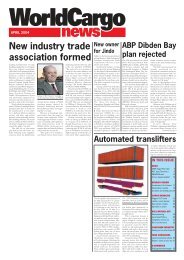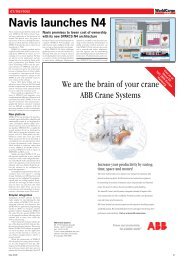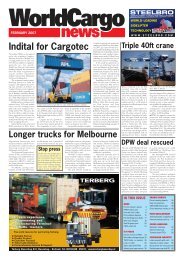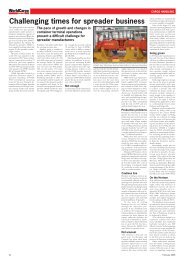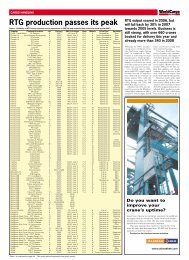WorldCargo News Online
WorldCargo News Online
WorldCargo News Online
Create successful ePaper yourself
Turn your PDF publications into a flip-book with our unique Google optimized e-Paper software.
CARGO HANDLING<br />
<strong>WorldCargo</strong><br />
news<br />
SOM others do have them!<br />
Much of the growth in the lift truck market<br />
over the last few years has been driven<br />
by the Asian market and it is not expected<br />
to slow down significantly in the next two<br />
years.The Asian Development Bank has<br />
just released its forecasts for developing<br />
Asian economies and forecasts that the<br />
region will achieve overall expansion of<br />
7.2% in 2006 and 7% in 2007. However,<br />
growth is not evenly spread as China, India<br />
and Korea make up 66% of demand<br />
in developing Asia.<br />
China production<br />
Both Kalmar and SMV Konecranes have<br />
begun assembling ECH mast trucks in<br />
Shanghai in recent months, joining<br />
Fantuzzi that has been turning out reach<br />
stackers and heavy FLTs from the Noell<br />
China plant for some time. Kalmar built<br />
its first ECH machines at its new facility<br />
in Lin Gan, Shanghai, near the foot of<br />
the Donghai bridge to Yangshan Island.<br />
Lift truck and ECH product line manager<br />
Dan Petterson did not want to discuss<br />
the customer but stated that “serial<br />
production has started and there will be a<br />
constant flow of deliveries from the new<br />
plant.”To begin with the plant is assembling<br />
DCE80 45E 7- and 8-high versions<br />
with a standard specification for “various<br />
Asian markets, not just China,” said<br />
Petterson.“We are continuously evaluating<br />
how to use our existing assembly<br />
plants in an optimal way and the Chinese<br />
plant is no exception.”<br />
Kalmar’s Ottawa facility in the US is<br />
currently assembling some medium FLTs<br />
(9-18t range,) but there are no plans to<br />
extend this to include the new DCF laden<br />
container handling mast truck in the immediate<br />
future.<br />
Two more manufacturers are assembling<br />
big lift trucks in China, while in India a<br />
major customer is asking for supply,<br />
operate and maintain (SOM) contracts<br />
<br />
<br />
<br />
<br />
China the ‘local’ content of machines can<br />
logically be expected to rise.<br />
Kalmar’s CEO Christer Granskog has<br />
said that one of Kalmar’s focuses in product<br />
supply is to increase supplies from<br />
“new cost competitive suppliers” including<br />
China. As other industries develop<br />
Chinese facilities more components will<br />
be able to be sourced locally.<br />
Indian file<br />
In a straw poll of lift truck agents at the<br />
<br />
<br />
<br />
TOC Asia exhibition in Busan last month<br />
India was tipped for strong growth in the<br />
next two years. Container Corporation<br />
of India (Concor) is about to embark on<br />
a major equipment replacement programme<br />
and has issued a request for expressions<br />
of interest to supply 25 reach<br />
stackers with 5-high capacity with a 45t<br />
load.This is believed to be the largest single<br />
order for reach stackers in India.<br />
The tender invites expressions of interest<br />
for “manufacture, supply, operation<br />
and maintenance” (SOM) of 25 reach<br />
stackers for 11 inland container depots<br />
across India. The operation and maintenance<br />
period is for five years from the date<br />
of commissioning “extendable by another<br />
3-5 years on mutually agreed terms.”The<br />
machines have to be delivered over a one<br />
year period from June 2006.<br />
While service contracts are becoming<br />
more and more common, requiring<br />
the manufacturer to provide drivers is still<br />
relatively rare in most markets. In India,<br />
however, Concor has been entering into<br />
this type of agreement since 2002 with<br />
Indital Construction Machinery.<br />
Indital ’s director Ravi Kumar explains<br />
that Concor has long used contractors to<br />
own and operate equipment at its terminals,<br />
but in 2002 decided to try a new<br />
scheme where Concor would purchase the<br />
equipment and the manufacturer or supplier<br />
would operate and maintain it.<br />
<br />
<br />
<br />
<br />
SMV as well<br />
SMV Konecranes has also begun assembling<br />
machines in China and the first<br />
ECH unit was assembled late last year. In<br />
2002 Konecranes opened a factory at<br />
Futurity Industrial Park in Putou District<br />
for EOT cranes and other industrial<br />
equipment and this was expanded last year<br />
to start production of heavy trucks.<br />
SMV Konecranes’ sales director<br />
Mikael Andersson says production for this<br />
year will be on a smaller scale but in 2007<br />
volume should increase to around 100<br />
units/year and include both EC and laden<br />
container handlers. To begin with production<br />
is just for Chinese customers but<br />
the facility is intended to serve a wider<br />
geographical area eventually. The company<br />
has no plans to scale back its production<br />
in Markaryd and with sales<br />
growth of over 40% for the last two years<br />
needs the extra capacity to meet demand.<br />
Assembling machines in China is always<br />
a difficult strategic decision as manufacturers<br />
have to negotiate a difficult import<br />
environment that can mean it is actually<br />
more expensive to bring in all the<br />
components and assemble them than to<br />
just import a machine made in Europe.<br />
They also have to decide how to manage<br />
Chinese expectations that a domestic<br />
machine will cost less than one built overseas.<br />
In other industries, automotive manufacturing<br />
for example, manufacturers<br />
sometimes use other specifications and<br />
locally sourced components to produce a<br />
cheaper ‘Chinese standard’ unit.<br />
Andersson says that SMV Konecranes<br />
decided early on against trying to develop<br />
a low price specification just for the local<br />
market. Although there are still important<br />
differences between regional markets,<br />
the company is aiming for a global specification<br />
where possible. Furthermore,<br />
many customers within China and the<br />
surrounding markets are global operators<br />
that want a global standard anyway.<br />
<br />
<br />
<br />
<br />
<br />
<br />
<br />
<br />
<br />
<br />
<br />
<br />
<br />
<br />
<br />
<br />
<br />
<br />
<br />
<br />
<br />
<br />
<br />
<br />
<br />
<br />
<br />
<br />
<br />
<br />
<br />
<br />
<br />
<br />
<br />
<br />
<br />
<br />
<br />
<br />
<br />
<br />
<br />
<br />
<br />
<br />
<br />
<br />
<br />
<br />
<br />
<br />
<br />
<br />
<br />
There and back again<br />
This approach does not necessarily preclude<br />
using “Chinese” components.When<br />
Kalmar began assembling terminal tractors<br />
in Shanghai it found some of the<br />
components shipped from the US in the<br />
first knocked down kits actually came<br />
from China in the first place.As more and<br />
more industries begin production in<br />
<br />
<br />
<br />
<br />
<br />
<br />
<br />
<br />
<br />
<br />
<br />
<br />
April 2006 23


